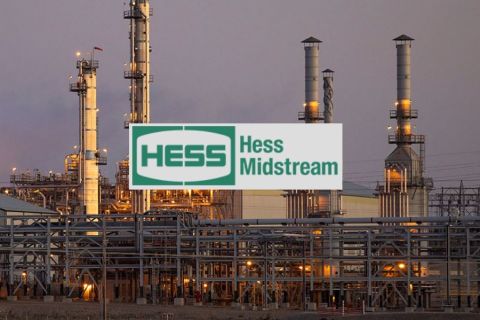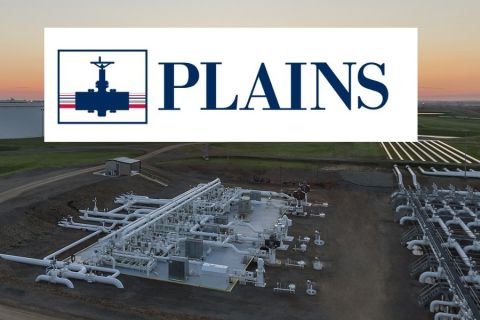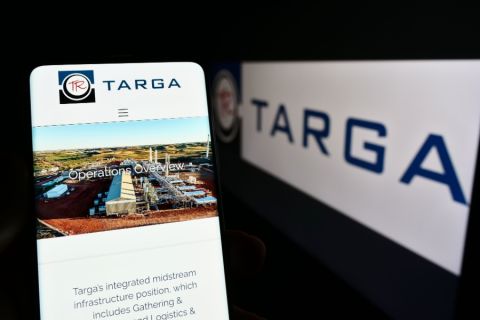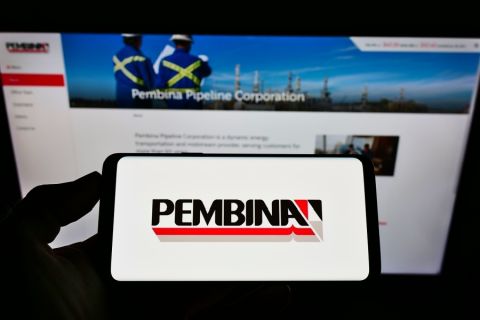Operators have 18,500 miles of new gas, crude-oil and petroleum pipelines across North America under way or in review. North American pipeline companies are building, planning and studying some 18,500 miles of natural gas, crude oil and petroleum products pipelines in the U.S. and Canada. The total represents an increase of roughly 4,000 miles since March 2005, and indicates that North America may soon see a renewed period of heightened pipeline construction activity, according to PipeLine and Gas Technology magazine. "I think we are already seeing a trend toward a lot of supply-driven projects focused on increased production coming out of the Rockies, on the prospects for new liquefied natural gas (LNG) terminals and increased LNG imports," says Donald F. Santa Jr., president of the Interstate Natural Gas Association of America. "There does seem to be an uptick in activity that's focused on the shifting supply sources." While much focus has been placed on efforts to bring Arctic gas to Canadian and Lower 48 markets, these projects are years away from construction start. In the near-term, pipeliners are making plans to move gas from the Rockies to regional and national markets through a number of projects. Construction of LNG facilities on the U.S. Gulf Coast is driving a number of plans in that region, as operators seek to connect new terminals to existing systems. In addition, growing U.S. crude oil demand, along with rising prices, has revived proposals to move production from Alberta's oil sands to regional and international markets. Arctic gas Discussions continue on the construction of a proposed $21- to $24-billion pipeline that would deliver natural gas from Alaska's North Slope to the Lower 48 states. Negotiations between Alaska and the three major North Slope oil producers-BP, ConocoPhillips and ExxonMobil-have been ongoing for more than a year, but have stalled at times over issues such as taxes, royalties and state ownership. The current plan calls for the pipeline to follow the 745-mile Alaska Highway route, approved by Congress in the Alaska Natural Gas Transportation Act of 1976. The pipeline would run with 52-inch pipe from the North Slope south along the Alaska Highway, and then into Alberta, where it could connect with existing systems. The state has sent a contract proposal to the producers, and Gov. Frank Murkowski has announced that the state had reached agreement with ConocoPhillips on the base fiscal terms of the contract, and that negotiations with BP and ExxonMobil were continuing. A contract with the state is seen as a crucial step in moving the project forward, but does not guarantee that the pipeline will be built. Meanwhile, Imperial Oil Ltd. reports that some progress is being made on the $3.73-billion Mackenzie gas project. In April, project developers halted field work and detailed engineering due to a lack of progress on key areas. Since then, project developers have been focusing on two fronts: negotiations with the aboriginal landowner groups on benefits and access agreements, and discussions with the Canadian and Northwest Territories governments on the fiscal framework. Imperial says that some progress has been made on these. The Mackenzie gas project is to move gas from the Mackenzie Delta southward through the Northwest Territories to Alberta. It calls for construction of the $2.6-billion, 758-mile, 30-inch Mackenzie Valley gas pipeline. It also calls for a 109-mile gas-gathering system, and a 295-mile liquids pipeline system. Rockies pipelines In the Lower 48, activity is mostly focused on natural gas transportation, and much of this on moving Rockies gas to regional and national markets. Perhaps most notable here is the Rockies Express pipeline, a $3-billion gas pipeline that would carry up to 2 billion cubic feet per day of Rockies production to markets in the upper Midwest and eastern U.S. Developed by Kinder Morgan Energy Partners and Sempra Energy, early plans call for the 42-inch line to run some 1,350 miles, from the Cheyenne hub in northeastern Colorado to the Clarington hub in eastern Ohio. Pending a feasibility study, shipper commitment and regulatory approval, the line is projected to begin service in late 2007. In October, El Paso Corp. announced the rival Continental Connector project, a new system that would add more than 1,000 miles of up to 42-inch pipe to move Rockies gas east. Construction is under way on the Entrega gas pipeline, another Rockies system. This is a 327-mile, 36- and 42-inch system that will move western Rockies gas from the Meeker hub to the Cheyenne hub. The line, developed by an EnCana subsidiary, is expected to be completed in the fall of 2006. The Kinder Morgan-Sempra Energy group says it will acquire the Entrega pipeline, and create an even larger system by connecting Entrega to the Rockies Express. And, there a number of other smaller, or midsize, Rockies projects being planned. El Paso has received Federal Energy Regulatory Commission approval for Wyoming Interstate Co.'s (WIC) Piceance lateral expansion. This will be a 142-mile, 24-inch line from the Colorado Interstate Gas (CIG) Greasewood compressor station in Rio Blanco County, Colorado, to the CIG Wamsutter station in Sweetwater County, Wyoming. WIC is also planning the Uinta Basin expansion project in eastern Utah that would add a 128-mile, 20- or 24-inch pipeline from a CIG plant in Uintah County to Kanda, where it will connect with existing systems. LNG-related pipelines Construction of LNG facilities along the U.S. Gulf Coast has spurred a number of pipeline projects. Cheniere Energy is planning three, the largest being its Creole Trail pipeline project in Louisiana. It involves a roughly 118-mile, dual 42-inch system that would move regasified LNG from a terminal on the Calcasieu Ship Channel to Rayne, Louisiana. Kinder Morgan is planning a $490-million, 137-mile gas pipeline from Cheniere's Sabine Pass LNG plant now under construction in Cameron Parish, Louisiana. Sempra Pipelines & Storage has announced plans for its Port Arthur, Texas, gas pipeline, a 70-plus-mile system that would connect East Texas and southern Louisiana, where several LNG import terminals are being developed. "Each LNG facility appears to be implementing large-diameter, high-volume offtake headers connecting to existing Texas and Louisiana pipeline capacity to assure that their LNG volumes can be received and distributed," says Skip Simmons, who follows North American gas and power markets for U.K.-based consulting group Wood Mackenzie. "The current philosophy of the LNG sellers is that this interim strategy is sufficient for the period to 2009. However, as most of the LNG parties are connecting these headers to somewhat-constrained portions of the existing Louisiana pipeline grid, and are often competing with one another for market share in the same pipeline segments, it will be necessary for the downstream pipelines, in the future-say five years out-to add additional pipeline infrastructure in Louisiana." Upper Gulf Coast Northeast Texas/northern Louisiana has become another area of growing activity, driven by increasing production from the Barnett shale and Bossier sand, and efforts to get that gas to market. A case in point is Kinder Morgan's proposed 38-mile Carthage pipeline, which would move gas from Beckville, Texas, to Stonewall, Louisiana. This line would deliver gas to several existing interstate systems via interconnects, and would terminate at a new $225-million pipeline being planned by Crosstex Energy. The Crosstex project would extend the LIG pipeline system from the Shreveport area to Natchitoches. CenterPoint Energy is planning a 168-mile, 42-inch pipeline to move gas from Carthage, Texas, to Perryville, Louisiana. The project, which is estimated to cost $375 million, is part of a CenterPoint agreement to move gas produced by XTO Energy. In addition, CenterPoint and Duke Energy are studying the feasibility of building a 250-mile line which would start at the terminus of the Carthage-to-Perryville pipeline, and extend to an interconnect with the Gulfstream Natural Gas System. If this project moves forward, it could give producers access to markets in the Southeast, Midwest and Northeast. Deepwater Gulf Efforts to produce in the deepwater Gulf of Mexico have prompted plans for new offshore pipelines-in unprecedented depths, in some cases. Perhaps most notable is Enterprise Products Partners' plan to build a $280-million, 140-mile, 24-inch gas line in the deepwater Gulf, in up to 8,000 feet of water. The Independence Trail line will deliver production from Independence Hub, in Mississippi Canyon Block 920, into the Tennessee Gas pipeline in West Delta 68. First production is expected in 2007. Amberjack Pipeline Co. LLC has agreed to build an oil pipeline for Chevron's Tahiti prospect in the Gulf in 4,000-plus-feet of water. Plans call for a 2007 completion. Enbridge Offshore Pipelines LLC says it will spend $100 million on its Neptune lateral project, which will connect the deepwater Neptune oil and gas field to existing offshore pipelines. The project involves building two 23-mile lines, a gas-gathering lateral and a crude oil lateral. Neptune Field is about 120 miles offshore Louisiana. A 2007 completion is planned. Meanwhile, Williams Cos. Inc. plans to extend its Canyon Chief and Mountaineer pipelines to support oil and gas development in Blind Faith Field in the deepwater Gulf. The $177-million project in approximately 7,000 feet of water in Mississippi Canyon blocks 695 and 696, and a mid-2007 completion is planned. Canadian oil sands Growing crude oil demand has revived Canadian heavy-oil production, and re-invigorated plans to move Alberta's oil-sand production to U.S. markets. Enbridge is moving forward with its $895-million Southern Access project, which will move 400,000 barrels per day of oil-sands crude into the U.S. Midwest and involves expansion of the company's main oil pipeline from Hardisty, Alberta, to Chicago, and possibly to Wood River and/or Patoka, Illinois. Perhaps even more notable is TransCanada's plan to build a $2.1-billion long-distance pipeline that would transport approximately 435,000 barrels per day of crude oil from Hardisty, Alberta, to Patoka, Illinois. The Keystone line would involve construction of some 1,100 miles of new pipeline in the U.S., while the Canadian portion includes an additional 220 miles of new pipe. Some 540 miles of existing TransCanada pipeline facilities would be converted from carrying gas to oil. In November, TransCanada and ConocoPhillips entered a memorandum of understanding in which ConocoPhillips has committed to ship crude oil on the proposed pipeline, and can acquire up to 50% ownership of it. Within Canada, pipeliners are seeking ways to move oil-sands crude to regional and even overseas markets. Enbridge wants to build two new long-distance pipelines that would link production near Fort McMurray, Alberta, to markets in Edmonton, Alberta, and British Columbia. One is the $338.5-million Waupisoo project, which calls for a 236-mile, 30-inch pipeline from the Cheecham terminal to Edmonton. Enbridge is also including a 236-mile, 16-inch diluent return line in conjunction with the Waupisoo crude oil pipeline. The other is the Gateway project, which involves building a $4-billion, 715-mile, 30-inch pipeline that would link Edmonton with Kitimat, British Columbia. Terasen Pipelines also plans to provide new crude oil transportation capacity, perhaps most notably with its proposed Corridor pipeline expansion. The project includes building a new 288-mile, 42-inch diluted bitumen line, and upgrading existing pump stations from Fort McMurray to the Edmonton area. The company has also announced a phased expansion of its Trans Mountain crude oil pipeline system. Line pipe, materials How will all these new lines affect price and availability of line pipe and other construction materials? Analysts have noted that line-pipe prices have increased in the last few years, even as North American pipeline construction activity has been declining. The reason, of course, is that international demand has been increasing dramatically. Renewed demand from North America will add more pressure. As a result, pipeline companies are now planning for longer lead times, as well as higher prices. "Last year we experienced a large increase in steel prices, due in part to the impact of worldwide demand for scrap and ferrous raw materials on the market," says Ron Hoepner, engineering manager for Tulsa, Oklahoma-based Williams Cos. Inc. Also creating a shortfall in supply is the removal of some steel-making capacity from the market. The result, notes Hoepner, is that "pricing on alloys is at an all-time high," with increased premiums for the X70/80 material grades. "In 2002, the price of DSAW X70 was on the order of $600 to $700 per ton," says Hoepner, "and we expect to pay $1,100 to $1,350 per ton FOB mill bare pipe in 2006." Hoepner also sees the lead time for line pipe increasing. "In years past, we were able to commit to an order for pipe during the third quarter," he notes. "We attempted to do this in 2005, but concluded that none of the approved [domestic] pipe mills could meet our delivery needs." Williams ended up placing an order with an overseas mill, but had to delay construction on various replacement projects until it arrived. As a result, Williams will try to identify its pipe needs during the summer of 2006, to insure timely construction starts for 2007, he says. Hoepner also sees lead times for valves increasing. In the past, deliveries ranged from in-stock to about 16 weeks. In 2005, Williams was advised by one of its primary suppliers that deliveries on large-diameter valves would be extended to almost six months due to major commitments for valves by other companies. Crosstex, which is examining several large potential projects in both Texas and Louisiana, has become familiar with these trends. "There is no question that the environment for constructing pipelines has changed drastically during the past few years," says Dale Christian, manager of engineering, corporate development, for Crosstex Energy Services LP. "Specifically, the availability and price of steel, contractor services, valves and even rights of way have been affected by demand for steel globally and a current frenzy of large pipeline projects that are being constructed not only domestically, but also abroad." Prices of commercial-grade steel, a benchmark for line-pipe prices, have increased dramatically from under $300 per ton in fourth-quarter 2003 and now stand at roughly $580 per ton, he adds. "Also, compression-equipment lead times have increased from between 12 and 16 weeks in 2003 to between 40 and 44 today. Lead times for valves, particularly 24-inch, have recently grown from between four and six weeks to between six and nine or more." Other industry observers tend to affirm these views. "I do see some pressure on some pipe manufacturing as far as production availability down the road," says Frank McWilliams of the Corus Group, which produces seamless pipe. "There is a tremendous amount of pipeline activity in North America coming up, and that will have an impact principally upon DSAW (double submerged arc weld) pipe mills and potentially on ERW (electric resistance welded) pipe mills." ERW will be more readily available, but DSAW may continue to tighten in availability. Normally in the past, the turnaround would be roughly 12 weeks for DSAW and seamless pipe. "Now, almost all mills have a seven- or eight-month timeframe, which is unusual," says McWilliams. "This will likely get worse, or become more extended, before it gets better." A new mill is being built by Oregon Steel Mills Inc., adjacent to Portland Steelworks, that will be capable of producing up to 170,000 tons annually in sizes ranging from 24 to 60 inches in diameter. Expected to come online in 2006, it should help alleviate market demand. Need for investment "Pipelines are essential but expensive," says Samuel Brothwell, senior analyst, Wachovia Capital Markets LLC. "Steel prices are pushing pipeline costs in excess of $1 million per mile, and few developers are willing to follow the 'build it and they will come' business model. "The reality is, 'we will build it, but first, you commit to it.'" Natural gas still favors pipeline transportation, but there are not enough pipelines to move gas from areas of growing production to increasingly supply-constrained gas markets such as New York, Brothwell adds. He does not believe that the gas-infrastructure sector is on the verge of a new golden era of 20-plus-percent annual growth, akin to the heady days of the late 1990s. "However, we believe the U.S. does face a very real natural gas supply crunch that will require new investment to solve, and that, in our view, should drive some solid investment opportunities that are likely to be sustained over a multiyear horizon."
Recommended Reading
Hess Midstream Subsidiary to Buy Back $100MM of Class B Units
2024-03-13 - Hess Midstream subsidiary Hess Midstream Operations will repurchase approximately 2 million Class B units equal to 1.2% of the company.
Plains All American Names Michelle Podavin Midstream Canada President
2024-03-05 - Michelle Podavin, who currently serves as senior vice president of NGL commercial assets for Plains Midstream Canada, will become president of the business unit in June.
Matador Completes NatGas Connections in Delaware Basin
2024-03-25 - Matador Resources completed natural gas pipeline connections between Pronto Midstream to San Mateo Midstream and to Matador’s acreage in the Delaware Basin.
Targa Resources Ups Quarterly Dividend by 50% YoY
2024-04-12 - Targa Resource’s board of directors increased the first-quarter 2024 dividend by 50% compared to the same quarter a year ago.
Pembina Declares Series of Quarterly Dividends
2024-04-10 - Pembina Pipeline Corp’s board of directors declared quarterly dividends for series 1, 3, 5, 7, 9, 15, 17, 19, 21, 22 and 25.





